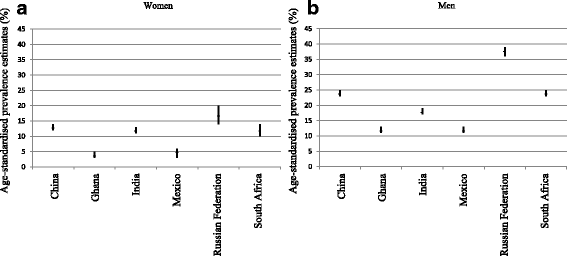Prevalence of arthritis according to age, sex and socioeconomic status in six low and middle income countries: analysis of data from the World Health Organization study on global AGEing and adult health (SAGE) Wave 1
- PMID: 28633661
- PMCID: PMC5479046
- DOI: 10.1186/s12891-017-1624-z
Prevalence of arthritis according to age, sex and socioeconomic status in six low and middle income countries: analysis of data from the World Health Organization study on global AGEing and adult health (SAGE) Wave 1
Abstract
Background: In higher income countries, social disadvantage is associated with higher arthritis prevalence; however, less is known about arthritis prevalence or determinants in low to middle income countries (LMICs). We assessed arthritis prevalence by age and sex, and marital status and occupation, as two key parameters of socioeconomic position (SEP), using data from the World Health Organization Study on global AGEing and adult health (SAGE).
Methods: SAGE Wave 1 (2007-10) includes nationally-representative samples of older adults (≥50 yrs), plus smaller samples of adults aged 18-49 yrs., from China, Ghana, India, Mexico, Russia and South Africa (n = 44,747). Arthritis was defined by self-reported healthcare professional diagnosis, and a symptom-based algorithm. Marital status and education were self-reported. Arthritis prevalence data were extracted for each country by 10-year age strata, sex and SEP. Country-specific survey weightings were applied and weighted prevalences calculated.
Results: Self-reported (lifetime) diagnosed arthritis was reported by 5003 women and 2664 men (19.9% and 14.1%, respectively), whilst 1220 women and 594 men had current symptom-based arthritis (4.8% and 3.1%, respectively). For men, standardised arthritis rates were approximately two- to three-fold greater than for women. The highest rates were observed in Russia: 38% (95% CI 36%-39%) for men, and 17% (95% CI 14%-20%) for women. For both sexes and in all LMICs, arthritis was more prevalent among those with least education, and in separated/divorced/widowed women.
Conclusions: High arthritis prevalence in LMICs is concerning and may worsen poverty by impacting the ability to work and fulfil community roles. These findings have implications for national efforts to prioritise arthritis prevention and management, and improve healthcare access in LMICs.
Keywords: Arthritis; Epidemiology; Low and middle income countries; Prevalence; Socio-demographic characteristics.
Figures
References
-
- Briggs AM, Cross MJ, Hoy DG, et al. Musculoskeletal health conditions represent a global threat to healthy aging: a report for the 2015 World Health Organization world report on Ageing and health. Gerontologist. 2016;56(S2):S234–S255. - PubMed
-
- Global Burden of Disease Collaborators Global, regional, and national incidence, prevalence, and years lived with disability for 301 acute and chronic diseases and injuries in 188 countries, 1990–2013: a systematic analysis for the Global Burden of Disease Study 2013. Lancet. 2015;386(9995):743–800. doi: 10.1016/S0140-6736(15)60692-4. - DOI - PMC - PubMed
MeSH terms
Grants and funding
LinkOut - more resources
Full Text Sources
Other Literature Sources
Medical


